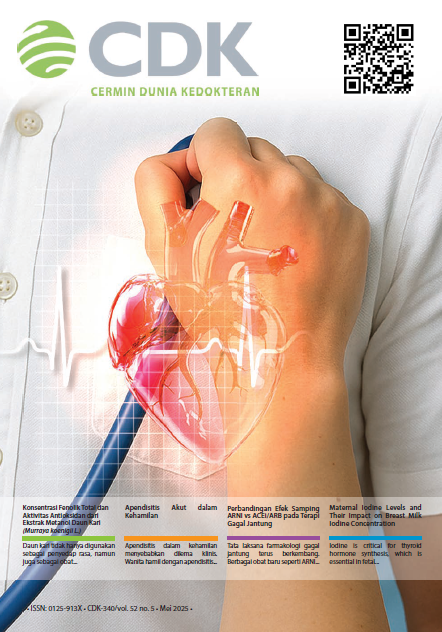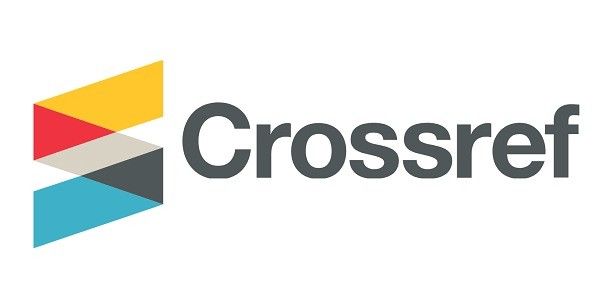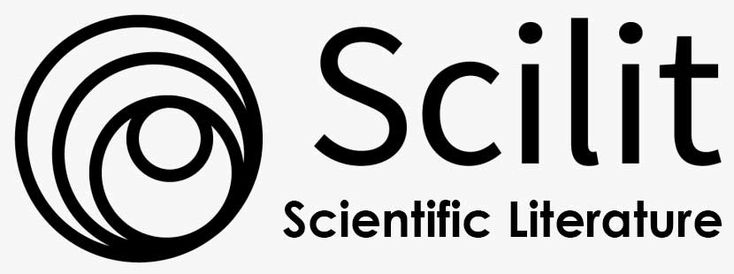Total Phenolic Concentration and Antioxidant Activity of Methanol Extract of Curry Leaf (Murraya koenigii L.)
Research
DOI:
https://doi.org/10.55175/cdk.v52i5.1333Keywords:
Antioxidant, curry leaf, methanol extractAbstract
Introduction: Curry leaves (Murraya koenigii L.) are plants that naturally grow in the Indian subcontinent, except at the peak of the Himalayan mountains, which in their development have spread widely to various corners of the world. Traditionally, curry leaves have been used by people as medicine. However, it is now known that this plant contains carbazole alkaloid compounds and polyphenols that have antioxidant activity. This is very useful for controlling free radical levels in the human body so that they remain within reasonable limits. This is very useful for controlling the levels of free radicals in the human body to stay within reasonable limits. Free radicals are produced by normal cell metabolism which has recently been associated with the pathophysiology of various diseases. Methods: This in vitro research was to determine phenolic content and antioxidant potential in methanol extract of curry leaves. Total phenolic content testing used the Folin-Ciocalteu method and expressed by Gallic Acid Equivalent (GAE). Total antioxidant capacity testing used the DPPH method and Trolox as a comparison solution. Results: The total antioxidant capacity is expressed in the form of IC50. The total phenolic content of curry leaf methanol extract was 4007.78 μg/mL or equivalent to 133.59 mg GAE/g DW and the total antioxidant capacity of curry leaf methanol extract was 37.418 μg/mL. Conclusion: The total phenolic content of curry leaf methanol extract is high (>5 mg GAE/g). Correspondingly, the total antioxidant capacity of curry leaf methanol extract is also classified as very strong (<150 µg/mL).
Downloads
References
Singh S, Madan Mohan Head S. CURRY LEAVES (Murraya koenigii Linn. Sprengal)-A MIRCALE PLANT. Indian JSciRes. 2014;4(1):46–52.
Abeysinghe DT, Kumara KAH, Kaushalya KAD, Chandrika UG, Alwis DDDH. Phytochemical screening, total polyphenol, flavonoid content, in vitro antioxidant and antibacterial activities of Sri Lankan varieties of Murraya koenigii and Micromelum minutum leaves. Heliyon. 2021 Jul 1;7(7). DOI: 10.1016/j.heliyon.2021.e07449.
Salomi MV, Manimekalai R. Phytochemical analysis and antimicrobial activity of four different extracts from the leaves of Murraya koenigii. Int J Curr Microbiol Appl Sci. 2016;5(7):875–82. DOI:10.20546/ijcmas.2016.507.100.
De Mello Andrade JM, Fasolo D. Polyphenol antioxidants from natural sources and contribution to health promotion. Vol. 1, Polyphenols in Human Health and Disease. Elsevier Inc. 2014;1:253–65. DOI: 10.1016/B978-0-12-398456-2.00020-7.
Martemucci G, Costagliola C, Mariano M, D’andrea L, Napolitano P, D’Alessandro AG. Free radical properties, source and targets, antioxidant consumption and health. Oxygen 2022;2(2):48–78. DOI: 10.3390/oxygen2020006.
Phaniendra A, Jestadi DB, Periyasamy L. Free radicals: Properties, sources, targets, and their implication in various diseases. Indian J Clin Biochem. 2015;30(1):11–26. DOI: 10.1007/s12291-014-0446-0.
Mohammed EA, Abdalla IG, Alfawaz MA, Mohammed MA, Al Maiman SA, Osman MA, et al. Effects of extraction solvents on the total phenolic content, total flavonoid content, and antioxidant activity in the aerial part of root vegetables. Agric. 2022 Nov 1;12(11). DOI: 10.3390/agriculture12111820.
Vernon L. Singleton, Rudolf Orthofer RMLR. Analysis of total phenols and other oxidation substrates and antioxidants by means of folin-ciocalteu reagent. Methods Enzymol. 1999;299:152–78. DOI: 10.1016/S0076-6879(99)99017-1.
Dhurhaina CE, Novianto A. Uji kandungan fenolik total dan pengaruhnya terhadap aktivitas antioksidan dari berbagai bentuk sediaan sarang semut (Myrmecodia pendens) Crescentiana. J Farm dan Ilmu Kefarmasian Indonesia 2018;5(2):62–8. DOI: 10.20473/jfiki.v5i22018.62-8.
Blois MS. Antioxidant determinations by the use of a stable free radical. Nature 1958;181(4617):1199–200.
Vasco C, Ruales J, Kamal-Eldin A. Total phenolic compounds and antioxidant capacities of major fruits from Ecuador. Food Chem. 2008;111(4):816–23.
Bastola KP, Guragain YN, Bhadriraju V, Vadlani PV. Evaluation of standards and interfering compounds in the determination of phenolics by folinciocalteu assay method for effective bioprocessing of biomass. Am J Anal Chem. 2017;08(06):416–31. DOI: 10.4236/ajac.2017.86032.
Rahayu, Ningsih S, Nehru FG, Amna U, Halimatussakdiah. Free radical scavenging activity of methanolic extract of temurui (Murraya koenigii L. Spreng) collected from Langsa, Aceh. IOP Conf Ser Earth Environ Sci. 2019;364(1).
Mustanir M, Al-Qarana TR, Gusvianna H, Saidi N. Analisa potensi ekstrak daun kari (Murraya koenigii L. Spreng). Talent Conf Ser Sci Technol. 2019;2(1):1–8. DOI: 10.32734/st.v2i1.300.
Ghazzawi HA, Al-Sayyed HF, Al-Kurd RA, Mwalla MM, Arafat TA, AbdelQader SM. Effect of different extraction solvents on the antioxidant content and capacity of nine seasonal fruits. Clin Nutr Open Sci. 2021 Aug 1;38:33–42. DOI: 10.1016/j.nutos.2021.06.003.
Boeing JS, Barizao EO, e Silva BC, Montanher PF, de Cinque Almeida V, Visentainer J V. Evaluation of solvent effect on the extraction of phenolic compounds and antioxidant capacities from the berries: Application of principal component analysis. Chem Cent J. 2014 Aug 22;8(1).
Anggriani D, Azila L, Rosnelly CM, Hisbullah H, Syaubari S, Mukhriza T. Antioxidant activity of Aceh curry leaves (Murraya Koenigii) extracted using various solvents. Journal of Applied Technology. 2023;10(1):24–9.
Downloads
Published
How to Cite
Issue
Section
License
Copyright (c) 2025 Ardhita Felicia Tanuhariono, David Limanan, Frans Ferdinal, Eny Yulianti

This work is licensed under a Creative Commons Attribution-NonCommercial 4.0 International License.





















